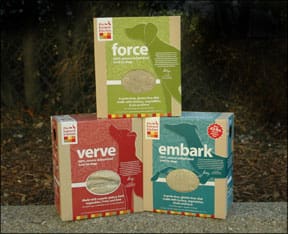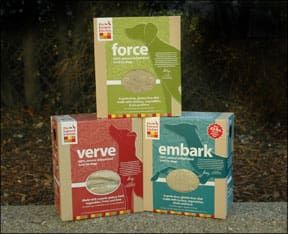The commercial pet food industry has enjoyed strong growth in the past two decades and spectacular growth in the past five years. According to Euromonitor International, an international market intelligence provider, sales of pet food in the U.S. exceeded $15 billion in 2007 up from $12 billion in 2002.
Some of this growth is due to an increase in the number of pets in the U.S. (Euromonitor estimates that there were 67 million dogs in the U.S. in 2007, 7 million more than in 2002.) But not all of the industry’s growth can be directly correlated to the increase in the number of canine and feline mouths to feed.
The pet food industry, like the human food industry, has become increasingly savvy about marketing essentially, selling more pet food than is actually needed. And empires are being built from the innovation of products that fill previously unnecessary needs. How did our dogs survive before they had special diets for seniors, large-breeds, small breeds, dogs of specific breeds? (Really? A food just for Yorkshire Terriers?)
Despite my skeptical tone, I’ve welcomed some of the industry’s advances, such as the increasing use of organic and other high-quality ingredients.

More recently, pet food manufacturing has seen a lot of innovation, as a growing number of entrepreneurs, thinking outside the conventional bags of dry food and cans of wet food, have developed entirely new ways to deliver high-quality nutrition to our dogs. Some of these developments make the products particularly useful for certain applications: such as dog food pre-mixes, which are formulated to contain everything a complete and balanced diet contains except for the fresh meat, which you provide. These are great for the person who wants to feed fresh, home-prepared food, but is worried about balancing the diet. Another convenient option are dehydrated foods, which are light and compact, and easy to take on the road; just add water!
Please note that some of these products are not formulated to meet the nutritional levels recommended by the Association of American Feed Control Officials (AAFCO). It’s easy to identify these products by the omission of a complete and balanced claim on their labels. In our opinion, the only people who should feed these products to their dogs are experienced, knowledgeable owners who would recognize the signs of nutritional deficiencies, or who have a close, collaborative relationship with a veterinarian who can provide educated oversight of such a feeding plan. For more on this topic, see Foods for Intermittent or Supplemental Use, or That Lack a Claim, on the next page.
Let’s look at some of these manufacturing innovations, and some of the products in each category.
Dog food pre-mixes
Pre-mixes are probably the oldest of the dog food innovations; Sojourner Farms, probably the oldest maker of dog food pre-mixes, was launched in 1985. The most basic concept behind the products in this category is just add meat (and water). The products generally resemble muesli.
As stated earlier, some companies guarantee that the addition of a specified amount of fresh, wholesome meat results in a diet that is complete and balanced (as per the AAFCO guidelines). Even without the complete and balanced statement, these products would be identifiable by one feature of their ingredients list: they generally contain added minerals; mineral levels are difficult to ensure through food sources alone.
Most of the pre-mix products contain grain; a notable exception is Sojourner Farm’s Europa Grain-Free Dog Food Mix, which contains dried vegetables, fruits, eggs, herbs, and a few other ingredients. Some contain whole grains that require cooking or soaking; in others, the grains are ground, and require only the addition of water. All of the products include dried vegetables, fruits, and/or herbs; some require the addition of some sort of healthy oil, in addition to meat and water. Some utilize organic ingredients.
All of these products may appear to be expensive, especially considering that you also have to buy fresh meat to complete the diet. However, because they contain so little water, when you calculate the cost of the reconstituted diet, their prices are generally competitive with other premium, healthy diets.
Dehydrated diets
Two types of dehydrated canine diets have emerged. The first are powdery products made by The Honest Kitchen (and no one else we are aware of); the second resemble freeze-dried hamburgers.
The Honest Kitchen, a San Diego-based company, seems to have single-handedly developed the concept of complete and balanced diets comprised entirely of dehydrated human foods, mixed together in a human food manufacturing facility. For most of its products, dried, ground meats and grains are mixed together with dried vegetables, fruits, and herbs; a 100 percent human food grade vitamin/mineral supplement is added to complete the diet to AAFCOs recommended nutrient levels.
With the exception of one formula, The Honest Kitchen’s diets require only the addition of water and stirring. However, the company’s founder, Lucy Postins, encourages owners to feel free to add fresh foods, such as vegetables and dairy products, to provide additional variety to the dog’s diet.
The company’s first product was a beef-based diet with organic grains, but The Honest Kitchen now offers six different canine diets, including five ‘complete and balanced’ varieties; one (Preference) that requires the addition of meat (like the pre-mixes discussed previously); and three grain-free varieties. We’ve toured The Honest Kitchen’s manufacturing facility, admired what we saw, and love these products.
A handful of companies offer a freeze-dried or dehydrated versions of their frozen diets. In most of these products, ground meat is mixed with other ingredients; then, instead of being frozen, the product has its moisture removed. The products are then contained in air-tight packages. Dog owners simply add water, wait, and feed.
These products are very popular with owners who feed their dogs raw diets at home, but prefer an easy-to-transport and prepare diet while traveling. All of the products we are aware of in this category are complete and balanced diets.
Dog food rolls
We have to admit that this is our least-favorite type of novel canine diet and that some of our readers swear that these products are the only type of foods that their finicky dogs will eat. Having nursed a very thin, senior dog who had almost no appetite through his final years on earth, we can appreciate that there is a time and a place for these foods. These products are also used by many positive trainers as training treats. Their texture, aroma, and taste (apparently) make them a high-value treat for most dogs.
All of the dog food roll products that we are aware of are complete and balanced diets. They generally contain a high percentage of animal protein including animal muscle tissue (including heart) and lungs, livers, kidneys, and spleens. Both of the two largest makers of these products list these organs by name and by species. This lends the impression that these are not the low-cost, bottom-of-the-barrel by-products found in bargain pet foods.
The products contain a lower percentage of moisture than conventional wet foods; they average about 40-43 percent moisture. This is closer to the moisture levels found in fresh meat; unlike with many canned foods, water is not needed for processing, and so none is added.
Everyone wonders: How can products that contain so much meat be stored at room temperature for up to a year, and remain wholesome? Preservatives are used, but the manufacturing process and the oxygen-free product packaging are key. Like canned foods, rolled products are actually cooked and sterilized of bacteria in the plastic packaging. Once the package is sliced open, the product must be kept refrigerated, and should be consumed within a few days.
Fresh-chilled
This is the newest type of novel canine diet to the marketplace. While frozen canine diets (raw and cooked) have been available for many years, only recently did a company roll out a complete and balanced fresh diet in the U.S. Interestingly, this sort of diet is highly popular in Australia, where the category comprises 20 percent of all the pet food sold.
There is only one company we are aware of that offers this type of diet here in the U.S.: the appropriately named Freshpet. The company was launched in 2006, and has reportedly experienced phenomenal growth, mostly through supermarket sales. The products contain no preservatives, are never frozen, and have a relatively short shelf life 13 weeks from manufacture to declared best by date.
Fresh-chilled products are by far the most expensive of the novel foods described here, but their availability in mainstream grocery stores, in refrigerator cases that are in close proximity to prepared human food products, seem to increase their attractiveness to many owners. The quality of the ingredients, the lack of preservatives, and the high inclusion of meat (the company claims the products are 70 percent meat), are terrific. We can’t imagine being able to afford to feed these products to anything but a very small dog, or a convalescing dog for a short period of time, however.





